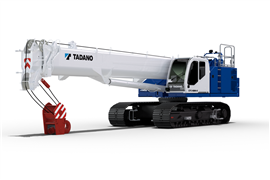Read this article in French German Italian Portuguese Spanish
How to provide smart site access solutions on wind farms
28 May 2024
As the world’s largest source of renewable energy, wind power is poised for continued growth. More than 70,000 wind turbines have been installed across the country, but did you ever stop to think how they got there? The all-encompassing answer is sustainable synergy – a mutually positive relationship between the environment, the community, wind developers and the teams that build wind farms.
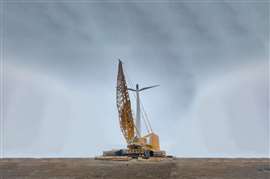 The first step to creating a safe work site is understanding the risks. For wind farm installation, this might include cranes tipping, mats sliding and working around heavy equipment.
The first step to creating a safe work site is understanding the risks. For wind farm installation, this might include cranes tipping, mats sliding and working around heavy equipment.
Renewable energy construction that is safe, efficient and environmentally responsible depends on collaboration and communication among multiple providers and stakeholders. From the moment a wind turbine leaves the manufacturing facility, well-constructed site access planning is a key part of the equation.
But the ideal locations for wind farms are often not the most accessible. Developers look at criteria like where the winds are high and few people reside, which often results in the selection of remote locations. It’s not uncommon for renewable energy construction to take place on rough terrain, mountainous areas, swampy land or other challenging conditions that require specialized solutions for safe access.
Access challenges
Although every site comes with its own set of obstacles, there are some common access challenges that are encountered when developing wind farms.
Mountain tops: Sloped surfaces can accelerate wind speeds, which is why wind farms are often found on hilltops and mountainous areas. These areas present unique challenges for wind farm installation and maintenance, including steep inclines, rocky terrain and crossing streams.
Open plains: The topography of open plains lends itself to high wind speeds, which is why you are likely to spot wind farms while traveling in the Midwest USA. Challenges of open plains include soft ground and traversing streams and culverts.
Turbine size and weight: Taller turbines are more efficient because they catch more wind. Taller towers and larger blades, however, are also heavier, which must be accounted for when planning site access solutions. Modern turbines are upwards of 500 feet (150 metres) tall and weigh hundreds of tons. Getting these components to the site efficiently and creating an environment for safe installation is critical for project success.
Equipment size and height: The heavy equipment used to transport and install wind turbines must also be considered when developing an access strategy. The cranes used to move turbine towers and blades can weigh hundreds of tons. When combined with the weight of the turbines themselves, this can present challenges to access teams that must create stable surfaces for heavy equipment.
Right-of-way challenges: Depending on the location, you might need to go through private or government land to get to the wind energy construction site. Doing this requires navigating access permissions, noise ordinances, traffic requirements, restoration requirements, and other requirements.
Environmental regulations: Rules can change between project initiation and implementation, possibly impacting site access strategy. Wind farm construction teams should also be aware of seasonal access limitations to accommodate migration, mating or growing seasons.
Although it is sometimes difficult, it is possible to overcome even the most challenging site conditions. This involves having the right team, materials, equipment and expertise.
Access mats for temporary roads: The types of access mats used to create temporary roads will depend on a number of factors, including ground conditions, size and weight of vehicles and equipment, frequency of travel and the like. To optimize costs, use light-duty mats when they are a suitable solution and heavy-duty mats when necessary.
Access mats for stable work surfaces: Light-duty to heavy duty mats can be layered to create a stable work surface for material staging areas and the operation of cranes and other heavy equipment. Crane matting can be moved around the site to relocate work platforms as turbine installation progresses.
Collaborative coordination
Early planning and communication are critical for ensuring the right mats are used in the right place at the right time. Access providers need to know the details of wind energy construction projects to calculate the most appropriate solutions for safe, efficient and environmentally responsible access. The top priorities for wind farm developers are to have no safety incidents and to minimize environmental impact on the site. In addition to being the right thing to do, prioritizing safety and being environmentally conscious will help you keep costs down and protect your brand.
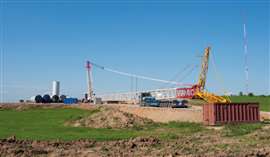 Creating an effective and sustainable approach to accessing renewable energy construction sites hinges on a dual foundation of expertise and communication.
Creating an effective and sustainable approach to accessing renewable energy construction sites hinges on a dual foundation of expertise and communication.
Protecting the ground from damage by using the appropriate access mats not only allows you to get equipment and materials to the site, but is also essential for complying with a stormwater pollution prevention plan (SWPPP). For renewable energy projects, having a proper SWPPP is often required to outline how you intend to implement erosion control measures and prevent runoff from entering waterways. This can include using access mats that distribute downward pressure on the ground to prevent soil compaction that contributes to erosion and limit the impact of moving heavy equipment and materials.
Protecting sensitive species is also key to environmental compliance. Native plants and animals may need protection, so you need to know how to identify them and avoid destroying habitats. You may also be required to implement measures that prevent the transfer of invasive species.
When the project is complete, the environment must be returned to its original condition or an agreed alternative. The better you protect the ground while working, the less you have to invest in restoration.
Safe work site
The first step to creating a safe work site is understanding the risks. For wind farm installation, this might include cranes tipping, mats sliding and working around heavy equipment. Once the risks are understood, provide site-specific safety training, daily toolbox talks and communication about evolving plans as the project progresses.
Creating an effective and sustainable approach to accessing renewable energy construction sites hinges on a dual foundation of expertise and communication. To ensure synergy throughout the project lifecycle, it’s crucial to prioritize these aspects.
First, sourcing a vendor with a proven track record in utility-scale projects is paramount. Providers seasoned in handling pipelines and power lines possess the specialized knowledge necessary for navigating the intricacies of renewable energy construction. Their expertise equips them to devise access strategies that uphold project timelines and fiscal parameters.
Moreover, experienced vendors are adept at managing unexpected challenges, having honed their ability to adapt swiftly when plans deviate. This adaptability is a valuable asset in the dynamic landscape of renewable energy construction, where unforeseen circumstances often arise.
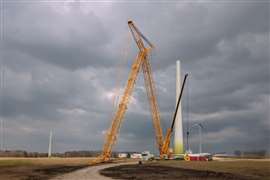 The cranes used can weigh hundreds of tons, and when combined with the weight of the turbines themselves, this can present challenges to access teams that must create stable surfaces for heavy equipment.
The cranes used can weigh hundreds of tons, and when combined with the weight of the turbines themselves, this can present challenges to access teams that must create stable surfaces for heavy equipment.
In addition, collaborating with vendors well-versed in SWPPP compliance offers significant advantages. These partners are instrumental in safeguarding your brand reputation and mitigating the risk of regulatory fines and penalties. By prioritizing environmental compliance from the outset, you not only uphold ethical standards but also foster a positive public perception of your project. Engaging vendors with a strong focus on SWPPP ensures environmental sustainability remains a cornerstone of your construction efforts.
In essence, selecting vendors with experience in utility-scale projects and SWPPP compliance enhances the likelihood of achieving sustainable synergy in renewable energy construction. Their expertise, coupled with effective communication channels, forms the bedrock for seamless collaboration and successful project outcomes. By prioritizing these factors, you establish a robust framework for navigating the complexities of renewable energy construction while maximizing efficiency and minimizing risk.
THE AUTHOR
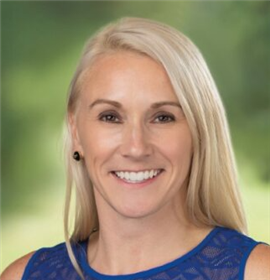
Kathy Hopper is a director of business development at United Rentals, specializing in identifying and cultivating growth opportunities for matting solutions. With more than 20 years of experience, she has a proven track record of driving growth and fostering lasting client relationships. Previously, she was executive vice president of sales and marketing at Yak Access.
STAY CONNECTED


Receive the information you need when you need it through our world-leading magazines, newsletters and daily briefings.
CONNECT WITH THE TEAM












